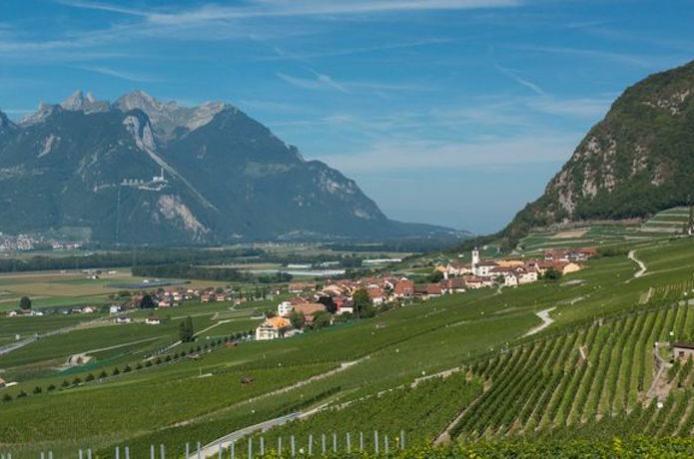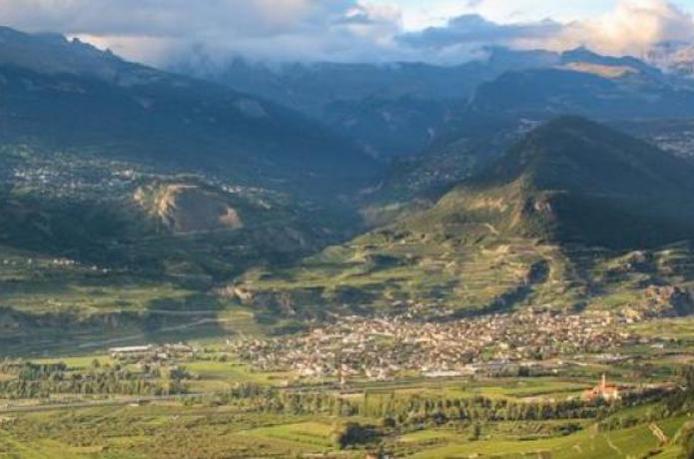Switzerland's stunning vineyards yield wine only found here
- Sunday 01 November 2015
Lauren Mowery is the weekly wine columnist as well as the coffee and tea columnist for The Village Voice. In 2013, Chasing the Vine was recognized as America’s Best New Wine Blog. A former New York litigator, she transitioned to the startup wine industry though Gilt Taste, before launching her own career as a wine and travel writer. In that span, she has traveled to over a dozen countries in the last two years, many of which are featured in her articles published in several magazines, including Wine & Spirits, Wine Enthusiast, Saveur, Tasting Panel, Alquimie, Punch, The Wine Merchant, Palate Press, Bar and Restaurant, Men’s Journal, and Fodors.com. Recently, she attained her WSET Diploma and hopes to enter the Master of Wine program in the fall of 2015.
Switzerland's vineyards hide in plain sight. It seems impossible that tourists driving around the compact country wouldn't notice the thousands upon thousands of green vines planted neatly across rows of stone terraces, yet Swiss winemakers report exactly that.
Perhaps the lack of alpine wine in travelers' domestic markets coupled with their single-minded focus when visiting — whether it be to ski Zermatt, hike the Rhone glacier or shop for watches — explains their failure to recognize how deeply Swiss wine culture is rooted. But the funny thing about finally noticing the obvious: Once you do, you'll see that object of your attention everywhere. And so it was during a recent trip to explore the wineries of Vaud, Valais and Graubünden; vineyards were everywhere.
For a country few associate with fermented grapes, Switzerland has a long, rich history of cultivation analogous to its better known neighbors France and Germany. In fact, just as monks carefully planted, observed and delineated the patchwork of venerated sites that now compose Burgundy, Lausanne's bishops in the 12th century also ordered the architecture of vine parcels out of the wild terrain surrounding Lac Léman (Lake Geneva).
Six regions, six identities
While vineyards are scattered across six regions, from Zurich to Geneva, and Neuchatel to Ticino, three cantons are particularly suitable for visitors due to their distinctiveness, the density and accessibility of the wineries, and the quality of the wine.
Vaud, a French speaking canton in the southwest corner of the country, encompasses much of Lake Geneva and the UNESCO World Heritage site, the terraced vineyards of Lavaux. These stunning sites soar from the edge of the lake precipitously towards the firmament at inclines you'd believe only angels could harvest. Chasselas, a delicate white, and the best known Swiss grape outside of Switzerland, shines here.
Southeast of Vaud lies Switzerland's warmest, most prolific growing area, Valais. The Rhone River cuts a wide, 100 km-long swath of hospitable channel, allowing for valley floor and slopeside viticulture. Valais produces an enormous range of grapes (some argue too many). Several, like Petite Arvine, have the quality and charm potential for international markets, except for infinitesimal production levels. But trying a wine you've never had and will never see elsewhere is part of the area's allure.
Continuing northeast across two harrowing mountain passes leads to German-speaking Graubünden, and the source of the Rhine River. The premier wine region of Bündner Herrschaft earned the monikers Heidiland and Little Burgundy, for two obviously different reasons. Johanna Spyri set her tale of a little girl from the Alps not far from the country's finest Pinot Noir vineyards. The Completer grape, an age-worthy rarity, is unique to the area.
Before you go, create a free account on swissfinewine.ch. The multiple-language site aggregates hard to find data in one place, like information on grapes, regions, wineries and wines. Users can track where they've been and where they want to go, along with the wines tasted with room to rate and comment. Contact information and maps are especially useful.
VAUD-LAVAUX
Fairytale scenery. Impossible vineyards. Alpine peaks and verdant pastures. Lake Geneva is trimmed in a landscape of contrasts that defines the clichéd term “indescribable beauty.” But there is nothing cliché about an 800-year-old wine region of which few have heard.
Outsiders have heard of the Swiss Riviera, defined end-to-end by the elegant towns of Lausanne and Montreux. They descend in droves throughout the summer seeking incredible views, balmy weather and a lively music scene. Freddie Mercury spent enough time in Montreux to earn a permanent perch on the riverfront.
Another draw, the La Prairie anti-aging center lures moneyed clients in search of the fountain of youth. Perhaps they are in the right place, but looking in the wrong spot. “The secret to longevity is a bottle of Chasselas a day,” suggests local winemaker Simon Vogel. ”Or at least, that’s what my grandfather preached, and he lived to be 99.”
VALAIS
Dramatic vineyards aren’t solely the domain of Vaud. Given Valais is home to the ski resorts of Verbier and Zermatt, it is logical that the highest grapes cultivated in the country reside here, too. Not to mention some of the most remote, difficult-to-pick locations, often planted to tiny plots of obscure grapes, the sight of which leave you wondering about the sanity of the growers. Petite Arvine, Cornalin and Chasselas, known locally as Fendant, are prevalent.
Wine isn’t the only prized product in the Alpine region. Warm and creamy, Raclette du Valais carries its own designation of origin. Legend has it a Valais vintner conceived the concept on a cold day when he melted a slice of raw milk mountain cheese over a wood fire. As though melted cheese needed inventing!
GRAUBÜNDEN - BÜNDNER HERRSCHAFT
In this picturesque slice of the Rhine Valley, producers cultivate an overwhelming 45 grapes, although visitors should focus on just two – one an international star, the other a local oddity.
Pinot Noir (aka Blaüburgunder) producers refer to their enclave as Little Burgundy for good reason. They make nuanced, elegant, age-worthy wines that win international honors, but limited production that is domestically consumed keeps this corner of fine wine country in relative obscurity. Though you wouldn’t know it walking the quartet of towns Malans, Jenins, Maienfeld (Heidi’s home) and Fläsch; each one is stacked with cellars, the streets supplied with maps and arrows to assist wine tourists. In addition to great Pinot Noir, Completer (a white grape first referenced in 1321), provides further wine geek bait. A handful of producers like Donatsch saved it from extinction to produce dry, high acid expressions that can evolve in the bottle for decades. Approximately five acres are cultivated, making it one of the rarest fine wines in the world.











